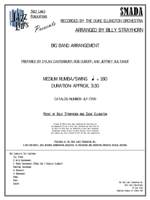SMADA
Recorded by the Duke Ellington Orchestra
Composed and Arranged by Billy Strayhorn, Prepared by Dylan Canterbury, Rob DuBoff, and Jeffrey Sultanof

Cat #: JLP-7399
$55.00This item usually ships within 1 business day.
Questions?
Please call +1-518-587-1102 or email us.
Edition: Jazz Big Band Arrangement
Description: Rumba/Swing - Medium
Publisher: Jazz Lines Publications
Billy Strayhorn's "Smada" has a long and somewhat unusual history. Originally written for a group called the Moonlight Harbor Band some time in the late 1930s, Strayhorn crafted multiple different arrangements of the tune before finally settling on the "final" version recorded by the Duke Ellington Orchestra in 1951. Even the title wasn't solidified until then; at various points prior, this song was known as "Ugly Ducklin," "Don't Take My Love" and "Jenny Lou Stomp." The version presented here is based off of the version recorded by the Ellington unit's 1967 tribute to Strayhorn "...and his mother called him Bill."
An 8 bar piano solo sets up clarinetist Jimmy Hamilton's entrance with the melody at measure 9. The tune itself is very pleasant to listen to while being extremely ahead of its time; its use of upper extensions in the melody and a 2-chord harmonic ostinato on the A sections (which were in place from the tune's humble beginnings in the late 1930s) predate and foreshadow both the bebop movement of the 1940s and the modal jazz movement of the 1960s.
The full ensemble enters at measure 33, with the saxophones playing a unison melody with some punchy background hits from the trombones. On the original recording, the arrangement has already hit a somewhat raucous pitch even at this early point. The saxophones split into harmony at measure 43 with continued brass backgrounds before returning to unison at measure 51.
Once the melody concludes at measure 59, the arrangement opens up into a feature for Hamilton, who solos the rest of the way minus the melody's re-entrance at 83. The backgrounds should remain supportive of the clarinet soloist, but the intensity and raucous quality of the arrangement should remain throughout. The brass in particular should over-exaggerate any short or otherwise punctuated hits with as much bite as possible to mimic the sound of Ellington's brass section on the recording.
Things finally begin to wind down at measure 107. The clarinet solo continues over the same unison sax melody and trombone backgrounds from measure 33, but this time a unison trumpet line (believed to have been written by trumpeter Clark Terry) adds a bit more depth. The ending of the arrangement can best be described as blunt, as the band comes to an abrupt and sudden halt with one final hit.
This arrangement is for jazz big band. The majority of this arrangement has been prepared from Strayhorn's sketch score and a set of original parts. Unfortunately, some sections of the trumpet and trombone parts are missing both from the parts and sketch score and appear to have been lost. These sections have been transcribed accordingly.
2 Alto Saxophones
2 Tenor Saxophones (Tenor Sax 1 Doubles on Clarinet)
Baritone Saxophone
4 Trumpets
3 Trombones
Piano
Bass
Drums
Trombone 1: Ab4




